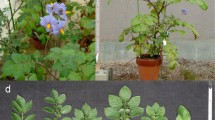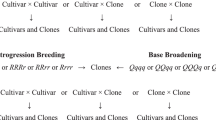Abstract
In the variety Arran Victory, which has purple tubers, there was found a tuber half purple and half pink. The pink half produced a plant which had pink tubers with small purple patches. X-ray irradiation of these tubers gave plants which had about five per cent of pink tubers without the purple patches. Breeding and eye-excision experments showed that the pink tubers with small purple patches were periclinal chimeras in which geneP had been lost from L1, L2 plus L3 still having geneP as in normal Arran Victory. The pink tubers without the purple patches had no geneP in L1, L2 and L3. The chimerical pink tubers had purple sprouts, the full pink tubers pink sprouts. The pigmented layer in the tubers of Arran Victory is the phelloderm (secondary cortex), not the primary outer cortex.
Similar content being viewed by others
References
Asseyeva, T. (1927). Bud mutations in the potato and their chimerical nature.J. Genet. 19: 1–26.
Asseyeva, T. (1931). (Bud mutations in the potato).Trudy prikl. Bot. Genet. Selek. 27: 135–217. (Russian with long English summary).
Dorst, J. C. (1952). Two remarkable bud-sports in the potato variety Rode Star.Euphytica 1: 184–186.
Howard, H. W. (1959). Experiments with a potato periclinal chimera.Genetica 30: 279–291.
Howard, H. W. (1960). Potato cytology and genetics, 1953–59.Bibliog. Genet. 19: 87–216.
Howard, H. W. (1961). Mericlinal chimeras in the potato variety Gladstone.New Phytol. 60: 388–392.
Howard, H. W. (1962). Experiments with potatoes on the effect of the pigmentrestricting geneM. Heredity 17: 145–156.
Howard, H. W. (1964a). The use of X-rays in investigating potato chimeras.Radiat. Bot. 4: 361–371.
Howard, H. W. (1964b). The experimental production of buds on the roots of potatoes.Nature 203: 1303–1304.
Howard, H. W. (1967a). Further experiments on the use of X-rays and other methods in investigating potato chimeras.Radiat. Bot. 7: 389–399.
Howard, H. W. (1967b). The chimerical nature of a potato wilding.Plant Pathol. 16: 89–92.
Klopper, K. (1965). Erfolgreiche experimentelle Entmischungen und Umlagerungen periklinalchimärischer Kartoffelklone.Züchter 35: 201–214.
Krantz, F. A. (1926). Genetic studies in potatoes. II The inheritance of red cortical colour in tubers.Proc. Potato Ass. America 13: 52–55.
Lunden, A. P. (1937). Arvelighetsundersokelser i potet.Meddel. Norges Landbrukhöiskole 20: 1–156.
MacKelvie, D. (1921). Bud variation.Rep. Internat. Potato Conf. (London): 35–40.
Miedema, P. (1967). Induction of adventitious buds on roots of the potato.Euphytica 16: 163–166.
Salaman, R. N. (1925). Genetic studies in potatoes: McKelvie's Arran Victory mutations.J. Genet. 15: 267–300.
Salaman, R. N. (1926). Potato varieties. Cambridge University Press.
Salaman, R. N. (1931). Somatic mutations in the potato.Rep. 9th Internat. Hort. Congr. (London): 117–140.
Author information
Authors and Affiliations
Rights and permissions
About this article
Cite this article
Howard, H.W. A full analysis of a potato chimera. Genetica 40, 233–241 (1969). https://doi.org/10.1007/BF01787353
Received:
Issue Date:
DOI: https://doi.org/10.1007/BF01787353




